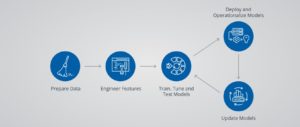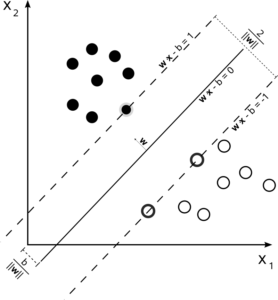Defining Machine Learning
Machine learning (ML) may have a rather different explanations, depending on whom you ask and where you look for. Following are the four practical definitions from reputable sources:
“Machine learning is the science of getting computers to act without being explicitly programmed.” – Stanford
„Machine learning algorithms can figure out how to perform important tasks by generalizing from examples.” – University of Washington
“The field of Machine Learning seeks to answer the question. How can we build computer systems that automatically improve with experience, and what are the fundamental laws that govern all learning processes?” – Carnegie Mellon University
“Machine learning is based on algorithms that can learn from data without relying on rules-based programming.” – McKinsey & Co.
Supervised learning
Supervised learning has an input variables (x) and an output variable (Y). An algorithm learns plotting the function from the input to the output.
Y = f(X)
The goal is to find the plotting function so that a new input data (x) can predict the output variables (Y). In Industry this dependent variable is called the predictor or the factor of interest for example., sales forecast, system-performance, specific optimisation parameter, marketing effectiveness etc
Supervised learning problems can be divided into regression and classification problems.
- Classification: A classification problem is when the output variable is a category, such as “high” or “low”, “full” or “empty”, “0” or “1” or “yes” or “no”.
- Regression: A regression problem is when the output variable is a real value, such as “number of produced bottles”, “weight”, “pressure” or “temperature” .
A support vector machine is a classifier that divides its input space into two regions, separated by a linear boundary. Here, it has learned to distinguish black and white circles.
Unsupervised learning
Unsupervised learning has an input variables (X) but not a corresponding output variable. Unsupervised learning problems can be divided into Clustering and Association problems.
- Clustering: A clustering problem discovers the characteristic groupings of data, such as grouping digital image processing for image segmentation.
- Association: An association rule-learning problem discovers rules that describe large portions of data, such as Amazon costumers that buy X also tend to buy Y.
Semi Supervised learning
Semi Supervised learning involves function estimation on labeled and unlabeled data. This approach is motivated by the fact that labeled data is often costly to generate, whereas unlabeled data is generally not.
Machine Learning in Industry
„Machine learning can be used in almost every facet of modern industrial processes, including improvements to product design collaboration and predictive operations.“ – industrial-iot.com
„Every manufacturer has the potential to integrate machine learning into their operations and become more competitive by gaining predictive insights into production.“ – Forbes
The following article 10 Ways ML Is Revolutionizing Manufacturing describe ten ways machine learning is revolutionizing manufacturing.


